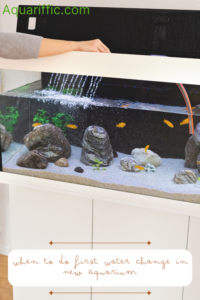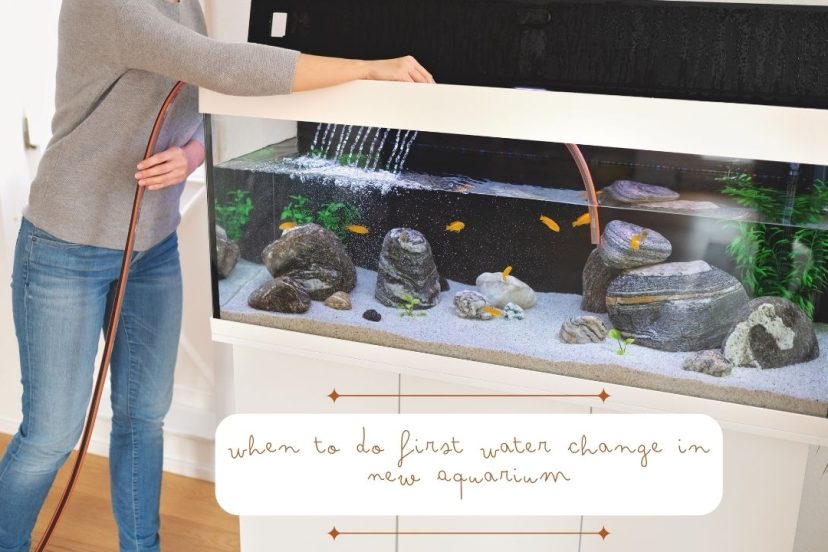When to Do First Water Change in New Aquarium
Setting up an aquarium can be an exciting adventure, but there’s a lot more to it than just picking out some colorful fish and a cool-looking tank. An important question many fish enthusiasts wonder is, when to do the first water change in a new aquarium?
Importance of Regular Water Changes
It’s crucial to understand that regular water changes are key to maintaining a healthy environment for your fish. Water changes help remove toxins, replenish essential minerals, and stabilize pH levels.
When to Conduct Your First Water Change
So, when is the right time for that first water change? Typically, it’s best to wait for at least a week after setting up a new tank before changing the water. This gives time for beneficial bacteria to establish themselves.
Preparing for Your First Water Change
Venturing into the realm of aquarium maintenance can feel daunting, especially when it’s time to perform your first water change. However, this essential step to ensure your fishy friends’ health doesn’t have to be overwhelming. With a little knowledge, some preparation, and the right tools, you’ll be ready to tackle it like a pro.
What You Will Need
Before you roll up your sleeves, let’s look at the tools of the trade:
- A Gravel Vacuum: This handy tool helps remove uneaten food, fish waste, and other debris that accumulate in the substrate, helping to keep the water clean.
- A Water Conditioner: Tap water contains chlorine and other chemicals that are harmful to fish. A water conditioner neutralizes these chemicals, making the water safe for your aquatic inhabitants. It also helps protect the fish’s mucus layer, which is their first line of defense against disease.
- A Bucket or a Water Changer System: A bucket is useful for small tanks. If you have a larger tank, consider investing in a water changer system, which connects to your sink and makes water changes easier and less messy.
- A Water Testing Kit: Regularly testing your water is crucial. Testing before and after a water change can help you understand the water’s chemistry and ensure it’s safe for your fish.
Steps to Follow
Now that you have your gear ready, here’s a step-by-step guide to your first water change:
- Turn Off All Electrical Equipment: Before you start, it’s a good safety measure to turn off the aquarium heater, filter, and any other electrical equipment. This not only prevents any electrical mishaps but also avoids damaging the equipment, as some heaters, for example, can break if they’re left on while exposed to air.
- Vacuum the Gravel: Start with your gravel vacuum at one end of the tank and slowly work your way to the other end, going into the gravel to siphon out water and trapped debris. Be careful not to stress or harm your fish during this process.
- Remove the Appropriate Amount of Water: Aim to remove around 10-20% of the tank’s total water volume for your first water change. Be sure not to remove too much at once, as it can cause a shock to the fish and disrupt the aquarium’s established balance.
- Prepare the New Water: Fill your bucket or water changer system with the same amount of water you removed. Make sure the temperature is close to that of the tank’s water to avoid temperature shock. Treat it with a water conditioner following the manufacturer’s instructions.
- Refill Your Tank: Add the new, treated water to your tank. Make sure the water flow is gentle to not stress the fish.
- Turn Your Equipment Back On: Once your tank is refilled, it’s safe to turn your equipment back on.
- Test the Water: After the water change, test the water parameters using your testing kit. This is to ensure everything is in the proper range and the environment is safe for your fish.
Remember, it’s completely normal to feel a bit nervous before your first water change. However, as you gain experience and see the positive impact on your aquarium’s health, it will quickly become a routine task. Pat yourself on the back; by taking this step, you’re helping to ensure a thriving environment for your aquatic pets.
After the First Water Change
Routine Maintenance Schedule
After your first water change, it’s best to establish a routine maintenance schedule. For most aquariums, changing 10-20% of the water weekly is a good rule of thumb.
Things to Watch Out For
Monitor your fish for any signs of distress after a water change. Also, test your water regularly to keep an eye on pH and ammonia levels.
Different Types of Fish and Their Needs
Freshwater Fish
Freshwater fish generally require less frequent water changes than their saltwater counterparts. Still, they require a stable environment, so regular testing and changes are necessary.
Saltwater Fish
Saltwater fish, on the other hand, need more frequent water changes due to the complexity of their habitat. Make sure to use marine-specific water conditioner and salt mix for these tanks.
The Role of Beneficial Bacteria in Aquariums
The health of your aquarium relies on a delicate balance, a miniature ecosystem teetering on the edge of chaos and tranquility. One key player in maintaining this balance is often unseen and unsung – beneficial bacteria.
In the natural world, bodies of water are inhabited by countless microorganisms, including bacteria, that form the base of the aquatic food chain and also help break down organic waste. Aquariums, despite being a controlled and often sanitized environment, also depend on these bacteria for the same reasons.
The Nitrogen Cycle – When to Do First Water Change in New Aquarium
The most critical role beneficial bacteria play in your aquarium is driving the nitrogen cycle. Fish waste, leftover food, and decaying plants generate ammonia, a toxic compound that’s deadly for your fish even at low levels. Here is where beneficial bacteria come to the rescue.
There are two groups of bacteria that are integral to this cycle:
- Nitrosomonas: This group of bacteria consumes ammonia and converts it into nitrite. Nitrite, while still toxic to fish, is the necessary second step in the nitrogen cycle.
- Nitrobacter: Nitrobacter bacteria consume the nitrite produced by Nitrosomonas and convert it into nitrate. Nitrates are far less harmful to most fish and can be kept in check with regular water changes and live plants.
The Importance of Cycling a New Aquarium
When setting up a new tank, it’s important to establish a healthy bacterial colony before introducing your fish – this is known as ‘cycling’ the tank. It takes a bit of patience, as growing a sufficient population of bacteria can take several weeks.
You can speed up this process by adding commercial bacterial starter cultures, but make sure to follow the product instructions carefully. The cycling process is crucial to ensure that the tank can handle the bio-load of your fish and effectively convert deadly toxins to less harmful substances.
Bacterial Blooms: A Sign of Imbalance
A sudden change in your tank conditions or an overload of nutrients may cause a ‘bacterial bloom’, where bacteria multiply so rapidly that the water becomes cloudy. This is often a sign that something in the tank is off balance and needs to be addressed.
While these bacteria aren’t harmful to your fish directly, they can consume a lot of oxygen, leaving less for your fish. The underlying issue causing the bloom, such as overfeeding or insufficient water changes, can also be harmful if not corrected.
Maintaining Your Bacterial Colony
Once established, it’s essential to maintain your colony of beneficial bacteria. They live in your filter media and substrate, so when cleaning, it’s important not to wipe them out completely.
When performing a water change, avoid cleaning all the tank elements simultaneously. Instead, try to rotate between cleaning the substrate, the sides of the tank, and the filter media. By doing so, you ensure you’re not eliminating too large a population of your beneficial bacteria at once.
In conclusion, these beneficial bacteria may be unseen, but their role is essential. By understanding and respecting their part in your aquarium, you can keep your aquatic pets happier and healthier.
Common Misconceptions about Aquarium Water Changes
A common misconception is that you can change all of the water at once. However, doing so can harm the balance of your tank, so stick to smaller, more frequent changes.
Conclusion – When to Do First Water Change in New Aquarium
Regular water changes are essential to maintaining a healthy aquarium. Always remember to monitor your tank’s conditions regularly, especially after a water change.
FAQs – When to Do First Water Change in New Aquarium
Can I use tap water for my aquarium?
Yes, but it must be treated with a water conditioner first to remove harmful chemicals.
How often should I test my aquarium water?
Ideally, test your water weekly, or if your fish show signs of distress.
Do all fish require the same water conditions?
No, different fish species have different water requirements. Always research your specific fish’s needs.
Can I use any salt for my saltwater aquarium?
No, you must use a marine-specific salt mix.
Can I overchange my water?
Yes, overchanging water can disrupt the balance of your aquarium, so stick to regular, smaller changes.





